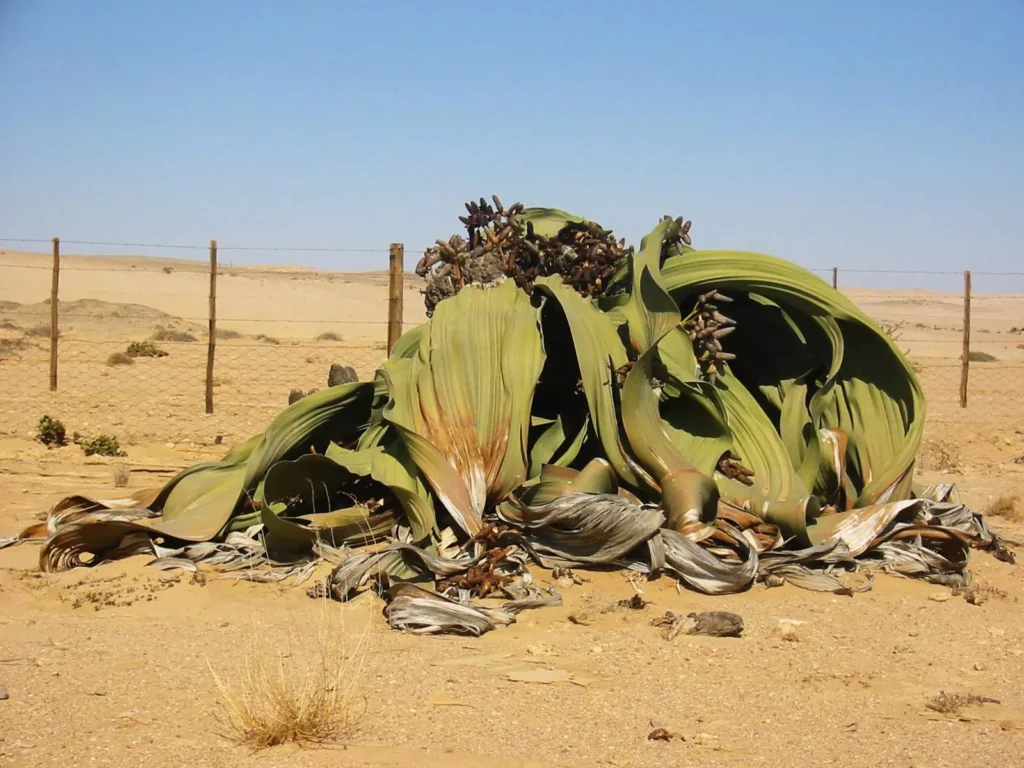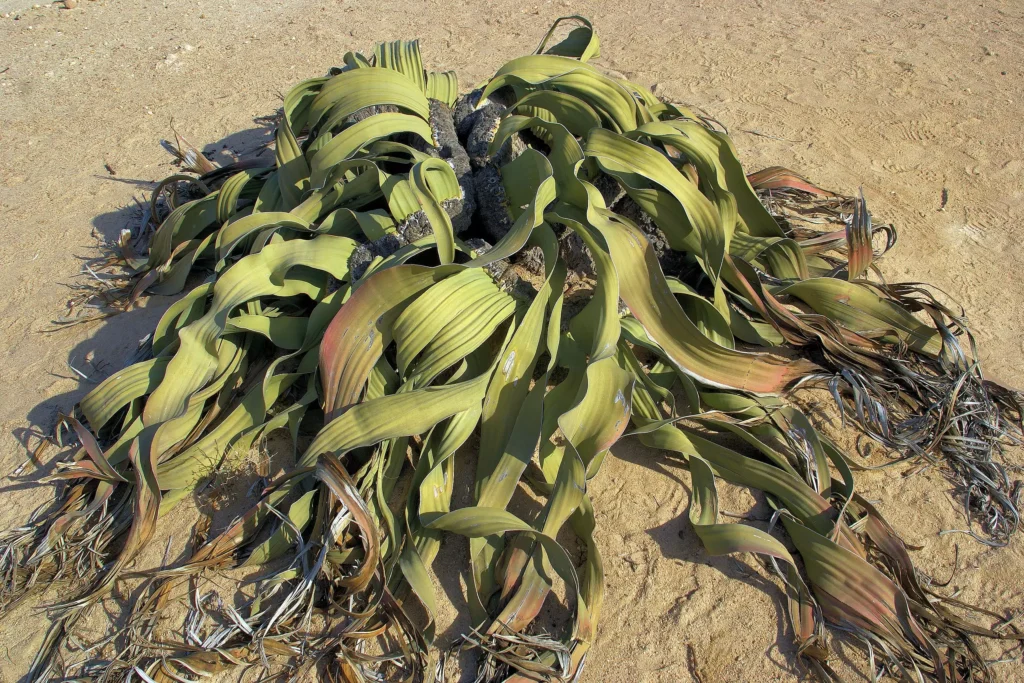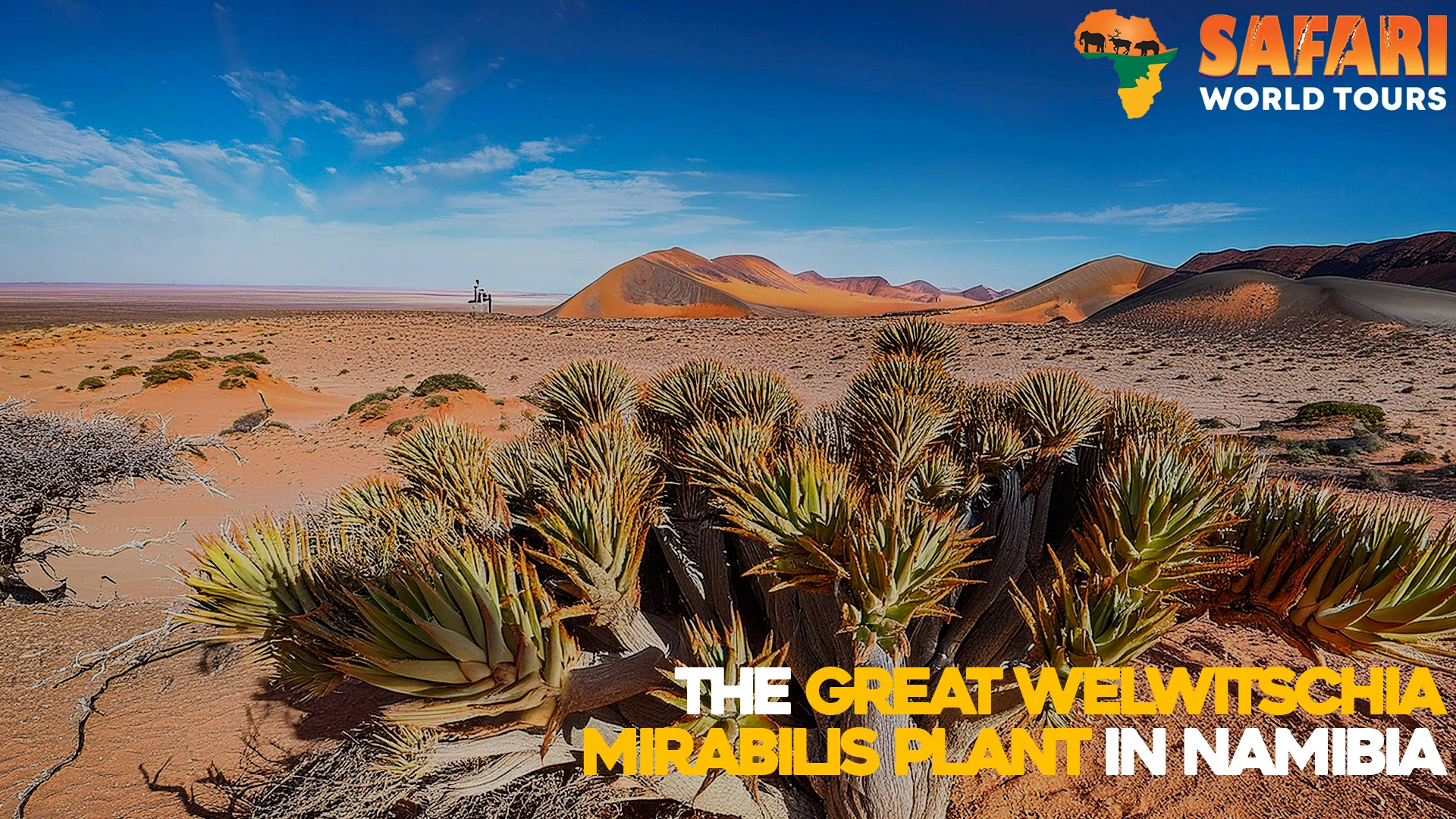Have you ever seen the wonderful Welwitschia plant? The Welwitschia is famous and endemic to the Namibian desert. It is given the nickname “onion of desert” because the core of the plant is often used for food, whether raw or cooked. The Welwitschia is an ancient plant and originates from the Jurassic period Welwitschia Mirabilis Plant.

The Welwitschia has unusually large leaves, and surprisingly, it adapts very well in extreme desert conditions because its uniquely structured leaves allow it to store up moisture which it absorbs from the dews that form at night. The plant usually grows in a dispersed manner; some of the plants are isolated from each other by several distances.
The Welwitschias mirabilis remarkably does not grow flowers but has naked seeds. The plant has just two leaves that continue to grow throughout its lifetime; its stem sits on firm roots. It is recorded to have a 20 inches growth in height and a length of 6.6 feet. The plant has a wide-range root and can expand well over a large area, even with low moisture.
HOW OLD IS THE WELWITSCHIA MIRABILIS?
The Welwitschia Mirabilis was discovered in 1859 and named after Friedrich Welwitsch, who discovered it. However, the plant’s specimen has been estimated to live as long as 1000 and 1500 years. As the years go by, the plant continues to become rare, but you can have a good sight of this wonderful plant when you come to Namibia.
WHY THE WELWITSCHIA MIRABILIS?
Called several names such as bizarre, weird, and strange, this plant remains a fascinating sight to see and is one of a kind because it is not a plant that anyone can just stumble upon by just walking on the road. Although it might be very tasking, however, the plant can be cultivated as a houseplant.
WANT TO VISIT?
This uniqueness of the Welwitschia Mirabilis is what attracts millions of visitors and tourists to Namibia. Wouldn’t you love to see one of the world’s rarest plants ever?
ACCOMMODATION

If you are going to be staying for a longer time, there are very fine and luxurious hotels and lodges that you will find very comfortable and affordable. They are situated in not-too-distant locations from where this magnificent plant grows.
Therefore, you can have unrestricted access to enjoy the wonderful sight of this wonderful plant. The Namib Naukluft Park has The Welwitschia drive, and you can take a round trip which takes about four hours, but you are sure to enjoy the unique beauty of the desert
Despite having just two leaves, you will be amazed how the plant’s stem widens into a concave disc as it grows. The Welwitschia mirabilis is well-respected in Namibia, so much so that it is represented in its national Coat of Arms, being placed in the compartment. This makes it a recognizable symbol and is a must-see for anyone who intends to visit Namibia, whether on a tour, vacation, or business engagement.
WHAT ARE SOME THREATS TO THE SURVIVAL OF THE GREAT WELWITSCHIA MIRABILIS PLANT?
The Great Welwitschia Mirabilis Plant is a unique and fascinating species that is endemic to the Namib Desert of Namibia and Angola. However, it faces several threats to its survival.
One of the chief threats to the Great Welwitschia Mirabilis Plant is habitat loss and fragmentation. As human populations in the Namib Desert continue to grow, more land is being converted for agriculture, mining, and infrastructure development, leading to the loss and fragmentation of the plant’s habitat. This can have a significant impact on the plant’s ability to survive and reproduce.

Another threat to the Great Welwitschia Mirabilis Plant is climate change. The Namib Desert is one of the most gasping places on Earth, and any changes in rainfall patterns can have a significant impression on the plant’s survival. Climate change can also cause changes in temperature and humidity, which can affect the plant’s growth and reproductive success.
Human activities such as overgrazing, trampling, and illegal harvesting of the plant for medicinal and ornamental purposes can also pose a significant threat to its survival. The plant is slow-growing and takes many years to reach maturity, so any damage to the plant can have long-lasting effects on its population.
Efforts are being made to conserve the Great Welwitschia Mirabilis Plant, including the establishment of protected areas, monitoring and research programs, and public awareness campaigns to promote its conservation.
FAQs
Q: What is the Great Welwitschia Mirabilis Plant?
A: The Great Welwitschia Mirabilis Plant is a unique and ancient plant species that is endemic to the Namib Desert of Namibia and Angola. It is known for its distinctive appearance and ability to survive in extreme desert conditions.
Q: How does the Great Welwitschia Mirabilis Plant survive in the Namib Desert?
A: The plant has a unique adaptation to the harsh desert environment, where it can absorb moisture from the air and can survive on very little water. It also has a surface root system that can spread out wide to capture water from a large area.
Q: Where is the Great Welwitschia Mirabilis Plant found in Namibia?
A: The plant is found in the Namib Desert of Namibia, particularly in the coastal areas between the Kuiseb River and the Ugab River.
Q: How long does the Great Welwitschia Mirabilis Plant live?
A: The plant is known to be long-lived and can survive for up to 2,000 years.
Q: What are some interesting facts about the Great Welwitschia Mirabilis Plant?
A: The plant has a unique appearance, with two long, strap-like leaves that grow continuously throughout the plant’s life. It is also popular for its ability to survive in extreme desert conditions and can withstand temperatures over 50°C.
Q: How is the Great Welwitschia Mirabilis Plant important to Namibia’s ecosystem?
A: The plant plays an important role in the desert ecosystem, providing a habitat for several species of insects and reptiles. It also helps to prevent erosion by stabilizing dunes with its root system.
Q: What are some threats to the survival of the Great Welwitschia Mirabilis Plant?
A: Threats to the plant include habitat loss and disintegration due to human activities such as mining and agriculture, as well as climate change, overgrazing, and illegal harvesting.
Q: How is the Great Welwitschia Mirabilis Plant being conserved in Namibia?
A: Efforts to conserve the plant include the establishment of protected areas, monitoring and research programs, and public awareness campaigns to promote its conservation.


